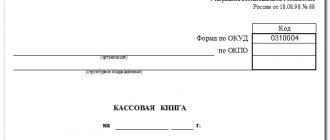The liquidation balance sheet is a key financial document that is formed at the final stage of activity. This document may be interim or final. The financial report discloses information about property balances, assets and debts to creditors.
To determine the actual financial condition of a closing organization, legislators provided for interim and final liquidation balance sheets. The reason for closing the business does not matter; this document will have to be drawn up in any case, since without it the Federal Tax Service will not register the termination of the legal entity’s activities in the Unified State Register of Legal Entities.
The procedure for liquidating a company is strictly regulated by law. In particular, according to the provisions of Article 61 of the Civil Code of the Russian Federation, the liquidation of a legal entity entails its termination without the transfer of rights and obligations by way of succession to other persons. This means that the concept of “liquidation” is final and irrevocable, so the last report is ideally zero. It is necessary to sell all assets or transfer them to interested parties during the organization’s activities. A report with figures is usually an interim liquidation balance sheet. It is noteworthy that the form of this report is not directly regulated by any regulatory documents, therefore it is filled out both in free form and using the forms of a regular balance sheet given in the appendix to the order of the Ministry of Finance of the Russian Federation dated July 2, 2010 No. 66n. This is what the Federal Tax Service of Russia recommends in its information “On the provision of documents upon liquidation of a legal entity.” But before drawing up a report, it is necessary to perform a number of actions provided for by the Civil Code and Federal Law No. 402-FZ on accounting, without which the document will not be accepted.
Stages of the liquidation procedure
To get an answer to the question “Should the liquidation balance be zero or not?”
Let's look at several points related to the liquidation procedure of an enterprise. In Art. 61–64 of the Civil Code of the Russian Federation highlight the stages that a company must go through during liquidation:
- Making a decision by the management body or the sole owner to close the enterprise.
- Informing the tax inspectorate about the decision made to change data in the Unified State Register of Legal Entities.
- Approval of the special liquidation commission.
- Public communication about the cessation of activities, for example, through the media, on Internet resources.
- Carrying out an inventory of property and liabilities, taking measures to collect receivables and notifying creditors of the liquidation of a legal entity.
- Drawing up an interim liquidation balance sheet.
- Final settlement with creditors.
- Drawing up the final (final) liquidation balance sheet
- Distribution of the property of a legal entity remaining after satisfying the claims of creditors to its founders (participants).
- State registration of the results of company closure.
So, during the liquidation process, several liquidation balance sheets can be drawn up: interim and final. However, they should not be the same.
Read more about the liquidation procedure in the article “Procedure for closing an LLC - step-by-step instructions.”
Reasons for closing a company
An exhaustive list of grounds for closing an existing enterprise is given in Article 61 of the Civil Code of the Russian Federation; there are only three global cases:
- on a voluntary basis, by decision of the founders or an authorized body, including the expiration of the period for which the legal entity was originally created and the achievement of the purpose of its creation;
- by a court decision (grounds, for example, carrying out prohibited activities, lack of a license, gross violation of the law or the Charter of the organization itself);
- as a result of financial insolvency.
The last case is the most severe and is separately regulated by the provisions of Article 65 of the Civil Code of the Russian Federation. In this case, the analysis of the liquidity of the balance sheet is especially important; it concerns the creditors of the bankrupt organization. True, in this situation external management is introduced, and all procedures with summing up the results fall on the shoulders of the arbitration manager. This is a separate topic, so we will consider, first of all, these actions by the organization itself and evaluate how the liquidation of an LLC with a zero balance occurs, i.e. when there are enough assets to satisfy the claims of all creditors.
Interim liquidation balance sheet
An interim liquidation balance sheet is drawn up by the liquidation commission only after the deadline for submitting claims by creditors (Clause 1, Article 63 of the Civil Code of the Russian Federation).
The interim liquidation balance sheet must contain information:
- about the property of the liquidated organization (based on inventory results);
- a list of claims presented by creditors and the results of their consideration;
- a list of demands satisfied by a court decision that has entered into legal force, regardless of whether such demands were accepted by the liquidation commission.
Data on property must be confirmed by inventory materials (clause 27 of the PBU on accounting and accounting, approved by order of the Ministry of Finance of the Russian Federation dated July 29, 1998 No. 34n). As a rule, the list of claims presented by creditors and the results of their consideration by the liquidation commission are given in the appendix to the balance sheet; the received document is numbered, stitched and sealed on the back. Thus, based on the requirements for the interim liquidation balance sheet, it can be argued that it cannot be zero.
The interim liquidation balance sheet is approved by the founders (participants) of the legal entity or the body that made the decision on liquidation. In some cases, the interim liquidation balance sheet is approved in agreement with the authorized government body. This procedure is provided for in paragraph 2 of Art. 63 Civil Code of the Russian Federation. Please note that you should not approve an interim liquidation balance sheet if at least one of the following circumstances occurs:
- the court accepted the creditor's claim against the liquidated company for proceedings, and the decision in this case (another judicial act completing the proceedings) has not yet entered into legal force;
- An on-site tax audit is being carried out in relation to the liquidated company, and the final document on it has not yet entered into force.
The law does not directly prohibit the approval of an interim liquidation balance sheet in each of such cases. However, if there is at least one of them, it is impossible to submit a notification to the tax authority about the preparation of an interim liquidation balance sheet (subparagraphs “b”, “c”, paragraph 4, article 20 of the law “On State Registration...” dated 08.08.2001 No. 129-FZ ).
Despite the fact that Law No. 129-FZ does not directly indicate the obligation to submit the interim liquidation balance sheet to the registration authority, it is necessary to submit it, since without an interim balance sheet it will be impossible to verify the reliability of the liquidation balance sheet. And the reliability of the liquidation balance sheet is a necessary condition for registering the liquidation of an organization.
Is it possible by one decision of an LLC participant to approve both the interim and liquidation balance sheets and submit all documents to the Federal Tax Service at the same time? ConsultantPlus experts provided detailed explanations. Get trial access to the system and review the recommendations for free.
Why is it needed and on what date is it compiled?
An interim balance sheet is necessary to determine the amount of funds owned by the organization. In fact, this money will be used to repay creditors' claims in order of priority. To generate the document, the data recorded in the last balance sheet before the start of the bankruptcy procedure is used. This is due to the fact that the company, after drawing up the protocol on the start of the liquidation procedure, no longer carries out its activities, so its financial condition does not change.
Typically, the date of preparation is the day that occurs two calendar months from the date of publication of information about the company being declared bankrupt. It is during these two months that all creditors have the opportunity to present their claims. In some cases, the liquidation commission sets a longer period for claimants to present claims, and therefore the period for drawing up interim reports may be extended.
As an example, we can consider a situation where the closure of a company is preceded by the expectation of payment of invoices. In this case, before drawing up a report, the liquidator waits for the assets of the enterprise to be replenished and VAT refunded from the tax office.
The final version of the document about the assets and debts of the company is drawn up after all the debts of the enterprise have been repaid. Usually it is zero. This document confirms that the basic requirements of creditors and regulatory authorities have been satisfied, taxes and payments have been paid, and the organization no longer has funds to carry out its business activities.
The liquidation balance must be zero or not
After all settlements with creditors have been completed, a liquidation balance sheet is drawn up, which must also be approved by the founders (participants) of the legal entity or the body that made the decision to liquidate the legal entity (clause 6 of Article 63 of the Civil Code of the Russian Federation). And here again the question arises: “Should the liquidation balance be zero or not?” The answer to this question is ambiguous. The fact is that at the moment there is no unified methodological approach, enshrined in the legal acts, to the procedure for compiling indicators of the final liquidation balance sheet. In addition, Art. 63 of the Civil Code of the Russian Federation does not establish the priority of drawing up a liquidation balance sheet before the distribution of property between owners. It only states that both of these actions must occur after the creditor has been repaid. It also makes it difficult to answer the question “Should the liquidation balance be zero or not?” the fact that the issue of the competence of the liquidation commission to independently make a decision on the distribution of property remaining after settlement with creditors among the participants (founders) is not regulated by law.
In principle, both positions are valid: that it should be zero, and that it can have indicators (except for the creditor).
Thus, if we assume that the liquidation commission is authorized to distribute the property remaining after settlement with creditors between shareholders and the liquidation balance sheet can be drawn up after the distribution of property, then the answer to the question “Should the liquidation balance sheet be zero or not?” positive.
If we assume that the decision on the distribution of property remaining after settlement with creditors is made by shareholders, and the liquidation balance sheet must contain information about such property, then the answer to the question “Should the liquidation balance sheet be zero or not?” negative.
Due to the uncertainty of the legislation on this issue, it seems that both of the stated positions may be valid, although each of them has its disadvantages.
To learn how property can be divided between participants, read the material “How is property distributed during the liquidation of an LLC?”
What form is used?
It is the liquidation commission that should be responsible for drawing up the final balance sheet, but in fact, employees of the company's accounting department are actively involved in this process.
There is no specific and strictly approved form of the liquidation balance sheet, therefore it is formed on the basis of the standard form of balance sheet No. 1. It is this form that is used when preparing reports for different periods of time, represented by a year or quarter.
Members of the commission can add different lines or items to the final liquidation balance sheet if necessary. In this case, specialists usually adhere to the same rules that are used when generating standard reporting. The final balance sheet must contain the following information:
- the book value of the assets remaining after all of the company's obligations to its multiple creditors have been fully repaid;
- the period for which the document is drawn up;
- current information about the direct company;
- in the section intended for liabilities, all obligations should already be absent, since they must be repaid before reporting;
- the final part of the document must contain information about the chairman of the liquidation commission, and he also puts his signature here with a transcript.
If the above information is not in the document, then it may not be accepted by the tax office, therefore, members of the commission should approach the preparation of reports responsibly. After the document is generated, the final liquidation balance sheet is approved, and the process is carried out by the persons who initiated the liquidation of the company. Usually the procedure is implemented by a meeting of the company’s founders. For this purpose, a protocol is drawn up, and marks are placed on the balance sheet indicating its presence.
Consequences of drawing up zero and non-zero balances
The disadvantage of the first position may be the presence of receivables among the assets of the liquidated organization, the collection of which may take quite a long time, and accordingly, the preparation of the liquidation balance sheet will be postponed for an indefinite period (until all receivables are repaid). The second disadvantage of this position is the uncertainty in the procedure for resolving a possible dispute between the participants regarding which of them should receive the remaining property. According to paragraph 8 of Art. 63 of the Civil Code, in the event of a dispute regarding which of the participants needs to transfer an item, the liquidation commission must sell this item at auction, but it seems that certain difficulties may arise with this issue, because this item, by decision of the liquidation commission, has already been transferred to one of the participants. Obviously, in this case, a zero liquidation balance can be approved only after the dispute between the participants is resolved.
The disadvantage of the second position may be the presence among the assets of the liquidated organization of property subject to transport tax and (or) property tax. In this case, the liquidated organization continues to remain a payer of these taxes, and before the distribution or sale of this property, it continues to form accounts payable for these taxes. And, therefore, in this case the liquidation balance sheet cannot be approved, since there will be tax payables.
What if you don’t close the LLC?
Closing an LLC is long and difficult, so organizations without employees, income and transactions are often found. Such firms do not pay taxes and contributions, but still must submit zero reports.
There are abandoned organizations that have no movements in their bank account and do not submit reports. If this continues for more than 12 months, the tax office has grounds to liquidate the LLC unilaterally without the consent of the founders. But this is a right, not an obligation of the tax office, so in practice it rarely happens. Much more often, an abandoned organization continues to be listed in the Unified State Register of Legal Entities, and is fined for failure to submit reports.
Another option to get rid of an LLC is to sell it. This is easier than closing an organization, but it has its downsides:
- This possibility should be provided for in the organization's charter.
- The purchase and sale agreement must be certified by a notary - this costs a minimum of 10 thousand rubles, and the maximum cost can reach 150 thousand.
Liquidation balance sheet: sample filling
The liquidation balance sheet does not have a specially approved form. It is filled out on the form adopted by order of the Ministry of Finance of the Russian Federation dated July 2, 2010 No. 66. Its name must be indicated: interim liquidation balance sheet or liquidation balance sheet. Such recommendations were given in the letter of the Federal Tax Service of Russia dated 08/07/2012 No. SA-4-7/13101.
On our website you can download the balance sheet form “Filling out Form 1 of the balance sheet (sample)” .
The liquidation balance sheet is prepared according to the same rules as the regular quarterly and annual balance sheets.
For information on how to fill out a balance sheet, read the article “Procedure for drawing up a balance sheet (example)” .
There are no special rules for drawing up an interim liquidation balance sheet (you can download a sample of filling out a zero balance sheet during liquidation on our website).
promezhutochnyy_dikvidacionnyy_balans.jpg
The interim balance is approved by the owners, recording it in the appropriate protocol and putting a note about it on the balance sheet. After approval, the report must be submitted to the Federal Tax Service. Along with it, a notarized notice in the form P15001 should be included in the package of documents. If necessary, such a balance can be drawn up repeatedly.
Latest financial statements
And a few more words about the financial statements of a liquidated legal entity. Features of financial statements during liquidation are given in Art. 17 of the Law “On Accounting” dated December 6, 2011 No. 402-FZ. The reporting year of the liquidated company is incomplete. It begins, as usual, on January 1, but ends on the date preceding the date of entry into the Unified State Register of Legal Entities about its liquidation. On the date preceding the date of entry into the Unified State Register of Legal Entities of an entry on the liquidation of a legal entity, the latest financial statements are drawn up. It must be compiled on the basis of the approved liquidation balance sheet and data on the facts of economic life that occurred in the period from the date of approval of the liquidation balance sheet to the date of entry into the Unified State Register of Legal Entities on the liquidation of the company. Thus, the latest financial statements are a successor not to the previous financial statements, but to the liquidation balance sheet.
In sub. 9 clause 3 art. 21 of Law No. 402-FZ states that the composition of the latest financial statements, the procedure for their preparation and the monetary measurement of objects in them should establish federal standards. But today such standards have not been approved and the procedure for submitting such reports to any government bodies has not been established.
If you decide to liquidate a joint stock company, use the step-by-step instructions from ConsultantPlus. Get trial access to the system and upgrade to the Ready Solution for free.
Methods for liquidating an LLC
In the modern economy, two main types of LLC liquidation can be distinguished: classic liquidation and alternative.
The classic liquidation of an LLC is a complete cessation of the organization’s activities after a decision has been made and all procedures provided for by the legislation of the Russian Federation have been completed.
Alternative liquidation includes several types and does not lead to a complete cessation of activity; rather, it changes the vector of the company’s activities. Let's take a closer look at what types of alternative liquidation there are. This:
- Change of general director;
- Change of founders;
- Merger with another company;
- Joining another company.
The first two points are essentially reminiscent of the sale of a company. It will be enough to conduct a full internal audit (more often this is done at the expense of the seller), eliminate all shortcomings and resolve issues with tax and accounting, and by means of a simple list of documents and amendments to the Charter and the Unified State Register of Legal Entities, transfer the LLC to the buyer for management.
The third and fourth points are more complex; to some extent, they can also be carried out in the form of a sale or other documents confirming entry into a holding or merger.
As you can see, with alternative liquidation, the company only changes its form, but remains active, although legally it is no longer the same company.
Results
The liquidation balance sheet can be interim and final. The intermediate version must reflect information about the obligations, property and capital of the organization, and also contain a list of claims presented by creditors, the results of their consideration and a list of claims satisfied by a court decision that has entered into legal force, regardless of whether such claims were accepted by the liquidation commission. The interim liquidation balance cannot be zero.
The final liquidation balance sheet is drawn up after the completion of settlements with creditors and in it the item “Accounts Payable” should be equal to zero. There is no clear answer to the question “the liquidation balance should be zero or not.” The liquidation balance sheet does not have a specially approved form and is filled out on the form of a regular balance sheet.
Sources:
- Civil Code of the Russian Federation
- Order of the Ministry of Finance of Russia dated July 29, 1998 N 34n
- Federal Law of 08.08.2001 N 129-FZ “On state registration of legal entities and individual entrepreneurs”
- Order of the Ministry of Finance of Russia dated July 2, 2010 N 66n
- Federal Law of December 6, 2011 N 402-FZ “On Accounting”
You can find more complete information on the topic in ConsultantPlus. Free trial access to the system for 2 days.
Liquidation balance sheets: the last days of the company in numbers
The article from the magazine “MAIN BOOK” is current as of July 19, 2013. M.A. Kokurina, lawyer
We thank Elena Kozenkova, chief accountant of EDV LLC (city) for suggesting the topic of the article.
Tolyatti). There are no special forms of interim and final liquidation balance sheets. And therefore, when compiling them, you can use the form of a regular balance sheet - it is simpler and more understandable.
We will tell you how to fill it out and what other documents need to be attached to the balance sheets.
The purpose of creating this document is to clarify the real financial position of the closing company and understand:
- you can satisfy all creditor requirements; who sent you a response with information about your debt (amount, details of the document confirming the debt);
- you will have to declare bankruptcy.
Therefore, an interim liquidation balance sheet is drawn up upon the expiration of the period announced by you for the presentation of claims by creditors.
Compilation deadline
The legislation sets a deadline for submitting the balance sheet, and the intermediate form must be submitted 2 months after publication in official sources about the beginning of the liquidation of the company. It is necessary to first notify all creditors of the planned event so that they can present claims to the company. The publication indicates the date when claims will be accepted.
The deadline for submitting the balance sheet, which is final, depends on how quickly the company can pay off all existing debts. If all debts are repaid, then this documentation can be generated. In this case, you cannot make any mistakes in the document, since under such conditions the balance sheet and the application for closing the company will not be accepted by the employees of the Federal Tax Service. Therefore, before drawing up documents, you should carefully evaluate the property status of the company and make sure that there are no debts.
How to fill out
The filling requirements are identical to the requirements for preparing interim and annual financial statements. The form of the document drawn up during liquidation indicates the following information:
- name of the institution and date of compilation;
- codes for all classifiers available to the company, tax identification number, checkpoint, type of activity;
- OPF, address, unit of measurement, currency;
- intermediate or final information.
The final financial statements indicate information about the assets to be distributed among the founders (all participants) of the enterprise.









